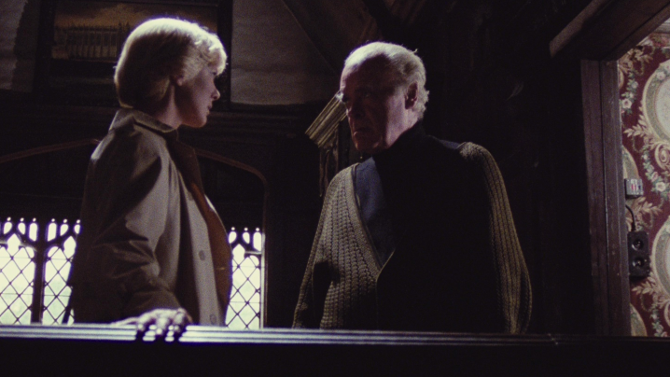“FOR the most wild, yet most homely narrative which I am about to pen, I neither expect nor solicit belief.” Edgar Allan Poe – “The Black Cat”
If thou darest, journey into the darkest depths of the supernatural gothic giallo thriller, Lucio Fulci’s 1981 horror feature The Black Cat, loosely based upon the Edgar Allan Poe short story that analyses the “spirit of PERVERSENESS” found deep within every human. A warning for those with a feline phobia, this can be seen as the Cujo of cat films.
Available in either Italian or the English language, the meandering tale is absurd in a sense, but a whole lot of fun. For the first fifteen or so minutes, we are not exactly sure what is happening, yet Fulci develops an intoxicating aura. Set in the English countryside, it seems like a black cat, with eerie yellow eyes, is killing people in the quaint little village. Often showing the feline’s perspective, we swiftly stock its prey too, eyeing the next kill.
We are also introduced to Jill Trevers (Mimsy Farmer), an American photographer working on a job researching the ruins in the area. She stumbles upon a mysterious ancient crypt, and finds an unusual recording device. Belonging to an old man that the rest of the community avoids like the plague, Professor Robert Miles (Patrick Magee) spends his evenings heading out into foggy cemeteries, trying to communicate with the dead.
After a young couple disappear, Inspector Gorley (David Warbeck) is summoned from Scotland Yard – a funny sequence in which he is ticketed by rural cop Sgt. Wilson (Al Cliver), even after he realizes the man is his superior. Suspicious occurrences continue to pop up throughout the county, but is it truly the black cat?
Centred on a mix of sumptuous visuals and Magee’s magnificent performance, the actor’s pointed eyebrows and yellow tinged eyes mirror that of the threatening beast. With a well-formed diction, every word brings forth a myriad of feelings – loneliness, pain, frustration and deep sadness, combined with a foreboding sense of danger. Fulci, connecting us to the characters by way of their eyes, utilizes intense closeups, proving that the eyes are indeed the windows to the soul. At one point, Miles and Trevers stare at each other through a hole in a wooden gate – with well placed shadows, it almost looks like their peepers have an upward angled appearance, much like cat eyes.
With a richly detailed setting, Fulci transports us into a world of catacombs, wood-panelled manors, swan-filled boat houses, outdoor landscapes with mysterious buildings as well as throughout the tiny historic village. For those passionate about architecture, there are many things to catch your eye. The foggy British countryside is a perfect setting for this style of horror film.
Filled with masterful deaths, Fulci relishes finding unique and out-there ways for people to meet their demise. Cat attacks are the least of your worries – a flaming car crash, suffocation in a dark room, and other macabre Poe-esque deaths. . . or near deaths litter the tale. Touching on the comic side of the preposterous narrative, one of the most humourous moments finds the cat stalking a drunkard who has just left the pub. Attempting to outwit the feline, (the cat is even able to open a door), it eventually leads to the gent trying to drunkenly stumble across a two by four to a ladder at the uppermost level of an abandoned barn, with a steep fall below. On a much darker side, there is a scene in which a fire is started. Utterly realistic and utilizing real fire, actress Dagmar Lassander was nearly killed when a piece of the set fell on her – thankfully, she escaped before any further danger reached her.
An intriguing concoction of supernatural giallo, several of Poe’s gothic horror tales (also think “The Tell-Tale Heart”, “The Murders in the Rue Morgue”), David Cronenberg’s The Brood, and one bedroom scene that will clearly bring to mind The Exorcist, The Black Cat is an example of style over substance, but don’t let that deter you. Though there are elements of the story that sadly go nowhere, it is still an original piece of cinema that is packed with unbelievably spooky visuals and intoxicating cinematography from Sergio Salvati. It also features a richly textured score from the great Pino Donaggio (Don’t Look Now, Carrie, Dressed to Kill) – hauntingly romantic with targeted horror elements. Though, in the end, it returns back to Poe and his themes, the cat a symbol of the evil deeds that can pounce from within. So, don’t block this one from your viewing list, it still has some life left in it.


